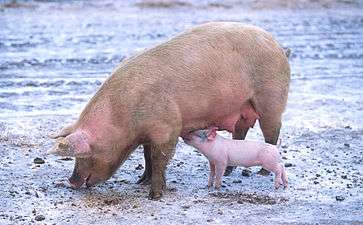Pork belly
|
Uncooked pork belly | |
| Nutritional value per 100 grams (3.5 oz) | |
|---|---|
| Energy | 1,456 kJ (348 kcal) |
|
8 g | |
|
26.4 g | |
|
15.8 g | |
| |
|
Source: [1] | |
Pork belly is a boneless cut of fatty meat[2] from the belly of a pig. Pork belly is popular in East Asian, European and North American cuisine.
Regional variations
This cut of meat is enormously popular in Chinese, Korean and Philippine cuisine.
China
In Chinese cuisine, pork belly (Chinese: 五花肉; pinyin: wǔhuāròu) is usually diced, browned then slowly braised with skin on, or sometimes marinated and cooked as a whole slab. Pork belly is used to make Slowly Braised Pork Belly (红烧肉) or Dongpo pork (东坡肉) in China (Sweet and Sour Pork is made with pork fillet).
Colombia
In Colombian cuisine pork belly strips are fried and served as part of bandeja paisa (chicharrón).
France
In Alsatian cuisine, pork belly is used to make choucroute garnie.
Germany
In German cuisine, pork belly is used to make schlachtplatte.
Italy
Pancetta is made from pork belly.
Japan
In Okinawan cuisine, rafute is traditionally eaten for longevity.
Korea
Koreans cook Samgyeopsal on a grill with garlic, often accompanied by soju.
Philippines
In Philippine cuisine, pork belly (Filipino: liyempo) is marinated in a mixture of crushed garlic, vinegar, salt and pepper before being grilled. It is then served with soy sauce and vinegar (toyo’t suka) or vinegar with garlic (bawang at suka). Pork belly prepared this way is called inihaw in Filipino and sinugba in Cebuano. Seasoned pork belly deep-fried and served chopped into pieces is called lechon kawali.
Switzerland
In Swiss cuisine, pork belly is used to make the Berner Platte.
United Kingdom
In British cuisine pork belly is primarily cooked using two methods. For slow roast pork belly the meat is baked at a moderate temperature for up to three hours to tenderise it, coupled with periods of approximately twenty minutes at a high temperature at the beginning or end of the cooking period to harden off the rind or 'crackling'. This is often accompanied by a sweet chilli baste or sauce. For barbecued belly pork the meat is seasoned and slow cooked in a pan by indirect heat on a covered barbecue, on a bed of mixed vegetables to which apple cider is added. Heat is again varied to produce tender meat with hard crackling. Pork belly is also used in the UK to make 'streaky' bacon.
United States
In the United States, bacon is most often made from pork bellies. Uncured whole pork belly is a popular dish as well.
Pork belly futures
The pork belly futures contract became an icon of futures and commodities trading. It is frequently used as a pars pro toto for commodities in general and appears in several depictions of the arena in popular entertainment (such as the 1974 movie For Pete's Sake the 1983 movie Trading Places and the 1991 cartoon "Ren and Stimpy").[3] Inaugurated on August 18, 1961 on the Chicago Mercantile Exchange (CME), frozen pork belly futures were developed as a risk management device to meet the needs of meat packers who processed pork and had to contend with volatile hog prices, as well as price risks on processed products held in inventory. The futures contracts were useful in guiding inventories and establishing forward pricing. The unit of trading was 20 short tons (40,000 lb or 18,000 kg) of frozen, trimmed bellies. (Bellies typically weigh around 6 kg (13 lb).) Pork bellies can be kept in cold storage for an extended period of time, and generally it was the frozen bellies that were most actively traded. Spot prices varied depending on the amount of inventory in cold storage and the seasonal demand for bacon as well as the origin of the pork; in the past, the former drove the prices of the futures as well.
In more recent years pork belly futures' prominence declined; eventually they were among the least-traded contracts on the CME, and were delisted for trading on July 18, 2011.[3][4]
See also
References
- ↑ "Korean Standard Food Composition Table, 8th Revision". National Institute of Agricultural Sciences. Retrieved 21 September 2016.
- ↑ Smith et al "Factors Affecting Desirability of Bacon and Commercially-Processed Pork Bellies," J. Anim Sci. 1975. 41:54-65.
- 1 2 Monica Davey (30 July 2011), "Trade in Pork Bellies Comes to an End, but the Lore Lives", New York Times, retrieved 16 May 2016
- ↑ Garner, Carley (January 13, 2010). "A Crash Course in Commodities". A Trader's First Book on Commodities. FT Press. Retrieved 6 December 2011.


